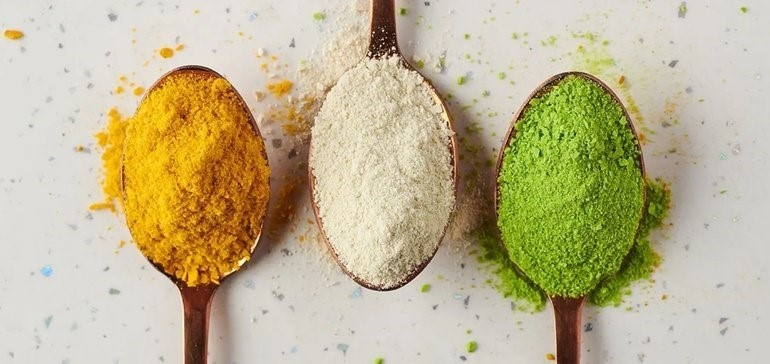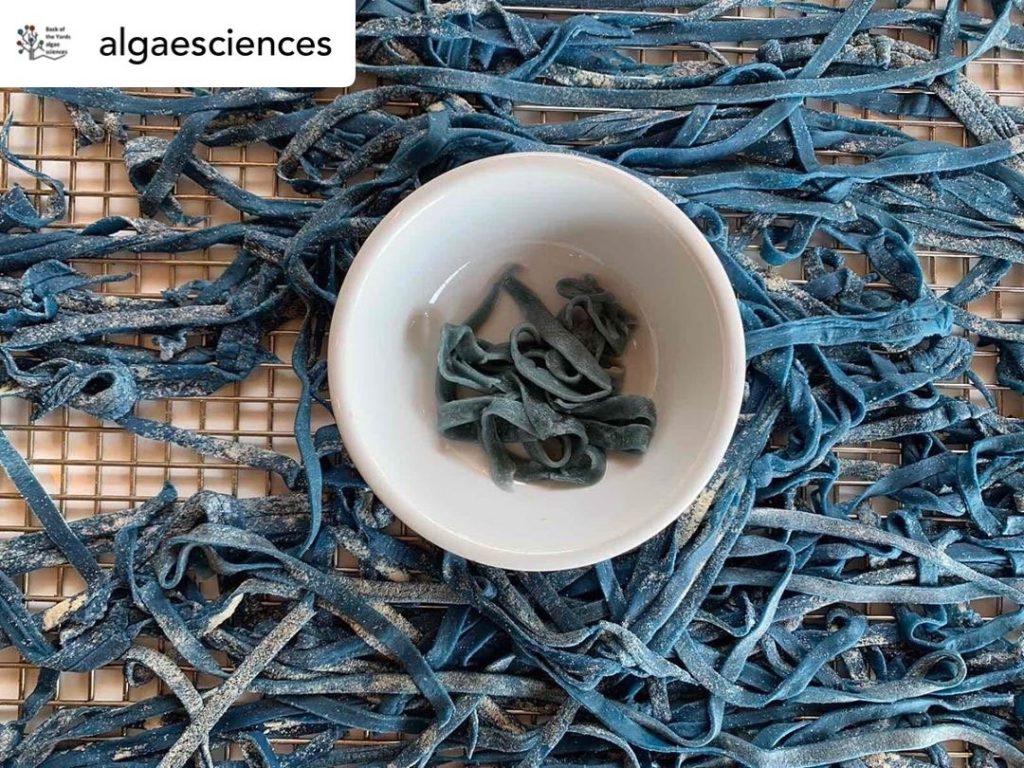How algae’s potential could make other ingredients green with envy
The one-celled organism can be cultivated anywhere — and with research and Big Food partnerships, it might be the next great sustainability story.

Retrieved from Algenuity on August 06, 2020
AUTHOR
PUBLISHED
Jan. 21, 2021
SHARE IT
When Mars Inc. announced in 2016 that it would remove all artificial colors from its human food products in the next five years, Leonard Lerer saw an opportunity.
Lerer, a medical doctor who had been an investor in food tech companies, had previously backed a startup that extracted a natural blue color from spirulina algae. And he had done the math: If Mars wanted to make its M&Ms a natural blue, Lerer estimated it would take five or six times all the spirulina in the world at that time.
The candy company immediately found the color change to be a big challenge. Almost five years later, M&Ms in the United States still don’t use natural blue coloring, Mars Wrigley said.
“Not only couldn’t they get enough, but the price which they could get [for] what they could get was too high,” Lerer said. “And there were a lot of technical problems with the production.”

Fast-Tracking R&D to Make Your Finished Flavors Better
Discover how food brands are synching their recipes with the latest consumer tastes and health trends.
However, Lerer was sold on algae’s potential. In 2018, he founded Chicago-based Back of the Yards Algae Sciences to scale up the startup’s way to extract blue from spirulina. The venture is paying off in terms of natural blue food coloring — Lerer plans to spin off a company this year that will be one of the three biggest producers of spirulina-based coloring in the world.
The venture is also paying off in very unexpected ways. While extracting the blue from spirulina, Lerer found the color was only 10% of the algae. The other 90% had value as a high-protein superfood — an ingredient that would be useful in plant-based meat, yogurt and cheese, as well as a culture medium for cell-based meat applications.

Permission granted by Back of the Yards Algae Sciences
While there are many things researchers are still studying about algae and its potential, it’s not just an area of curiosity for food science. It’s getting to be big business. Market Data Forecast projects that the global algae ingredients market will increase at a compound annual growth rate of 8.2% between 2020 and 2025. Global Market Insights predicts the global algae protein market will be worth $1 billion in 2026. Major manufacturers, including Unilever and Nestlé, have partnered with algae companies to develop new ingredients and applications for the one-celled organisms. Ingredients companies, including ADM and Bühler, are also working with algae.
Sabina Vyas, senior director of strategic initiatives and communications for the Plant Based Foods Association, sees more companies using algae ingredients now — both PBFA members and others. As an ingredient, algae checks off several boxes: It’s sustainable, climate-friendly and full of nutrients, including the omega-3s that are easiest to get from seafood. And algae ingredient companies are listening to what the manufacturers want.
“From what I’ve seen, they really want to work with companies based on what their needs are and be able to have their algae adapt to those needs,” Vyas said. “So we’re probably going to see more of that in eggs and meat alternatives. Maybe it’s going to become more of a protein add-on for foods, like spirulina or chlorella.”
We’re covering the news relevant to you.
Help us get it right by telling us more about you.
Top of Form
Company name
Company type Food Ingredient Manufacturer Food Processing Agricultural Organization/Farm Food Design Firm Convenience Store Food Distributor Food Packaging Food Service Food Production Equipment Grocery / Food Retailer Food/Beverage Testing/Inspection Beverage Manufacturer/Distributor Beverage Processing Company Beverage Retailer Research Organization Restaurant/Restaurant Chain IT/Software Development Firm Academia, College/University Consulting Financial Services / Investor Government/Regulator/Policy Maker Law Firm Media / Analyst / Trade Association / Professional Society Recruiting and Staffing Firm Other
Submit
Bottom of Form
Why algae?
Algae are literally everywhere.
The single-celled organisms grow in freshwater, saltwater and wastewater. Algae can grow and flourish in the sun through photosynthesis, but it can also grow in the dark. And it can be cultivated without using land or a large amount of natural resources.
Alexander Mathys, the head of the Sustainable Food Processing Laboratory at Swiss research university ETH Zurich, estimated there are more than 200,000 species of microalgae — unicellular varieties of algae — in the world. Only a handful are currently cultivated for food ingredients, meaning there is exponential potential for algae in the future.
“I think algae can solve some of the problems which the planet has,” Back of the Yards’ Lerer said. “And the reason for that is fundamentally … algae are at the bottom of the food chain. That means that algae and [basic fungus] mycelia are basically what everything on the planet needs to live.”
That back-to-the-basics attitude about algae has launched businesses and research. British ingredients company Algenuity, which formally partnered with Unilever last year, got its start about 10 years ago, when a group of scientists and engineers in the U.K. started looking at the possibilities of using algae in applications like biofuels. This group devoted resources to studying algae’s potential in energy and other areas.
“I think algae can solve some of the problems which the planet has. And the reason for that is fundamentally … algae are at the bottom of the food chain. That means that algae and [basic fungus] mycelia are basically what everything on the planet needs to live.”
Leonard Lerer
Founder and CEO, Back of the Yards Algae Sciences
Algenuity founder and CEO Andrew Spicer, a molecular and cell biologist, zeroed in on its potential in food. Spicer said that Algenuity essentially incubated in a larger company, and it had the funding and freedom to dive deep and build expertise in algae.
“As the whole plant-based ingredients trend truly exploded, we were really ready to go,” Spicer said. “We knew which algae to go to. We knew a big opportunity that was waiting to be exploited.”
But while algae is everywhere, it’s not as cost-effective to use as an ingredient as it would seem — it takes a lot of energy and water to harvest. Today, microalgae is less cost-effective than soy, Mathys said. But soy cultivation is encroaching on habitats, including the rainforest, while microalgae can be cultivated almost anywhere.
At ETH Zurich’s Sustainable Food Processing Laboratory, Mathys and other researchers are working on ways to make microalgae a more cost-effective and environmentally efficient protein. The team is developing a technology called nanosecond pulsed electric field processing, which uses alternating high electric fields to grow microalgae up to 17% more efficiently. The technology can also open up the microalgae while it’s still in the water, letting growers extract some of the protein components without having to remove it and keeping it alive. Mathys described this process as “milking” the algae.
The researcher has also investigated potential applications for microalgae. In a paper published last year in the journal Innovative Food Science & Emerging Technologies, Mathys wrote about turning yellow bright microalgae protein into a meat analogue. He believes this kind of application can inspire more manufacturers to use the ingredient, bringing a greater scale and lower cost.

Permission granted by Back of the Yards Algae Sciences
“We have to optimize it, first of all,” Mathys said. “Second, besides optimizing, we have to scale it to the economy of scale. For soy, that’s millions of tons. It’s amazing. Soy is delivering so much.”
Spicer said Algenuity’s partnership with Unilever has opened doors, both for the company and the entire algae business. Nestlé announced a similar partnership with Corbion, the owner of algae ingredients company AlgaVia, in 2019. These developments show that algae is finally gaining traction after so much speculation, Spicer said.
“I often quote the Elvis song: ‘A little less conversation, a little more action,’ ” he said. “We have had so much conversation over the last 10, 20, 30 years, and not as much action. It’s kind of fallen short in many cases. I think when you get companies like Unilever … stepping out and saying, ‘We’re gonna actually make this happen,’ it starts to make other smaller companies and opportunities arise.”
Where can algae be used?
Algae not only grows everywhere, but it can also be used almost anywhere in cuisine, according to researchers and ingredients companies.
Much of the world has thought of algae as a green and slimy substance that could fit into a niche in the nutraceuticals market, but Algenuity’s Spicer found it really shined as a nutritional component. Its high amino acid and fiber content are the types of things in demand by manufacturers and consumers. Chlorella vulgaris, the species that Algenuity’s ingredients are built around, is also non-allergenic. What’s holding it back, Spicer said, is its green color and bitter taste.
Spicer worked on formulating an ingredient that met all of those needs. The company created a strain of chlorella vulgaris that essentially has no chlorophyll, meaning it isn’t green. In doing that, the resulting protein also lost the bitterness, making it a fairly neutral-tasting and nutritious ingredient. Spicer said it has several functional properties as well.
“We have had so much conversation over the last 10, 20, 30 years, and not as much action. It’s kind of fallen short in many cases. I think when you get companies like Unilever … stepping out and saying, ‘We’re gonna actually make this happen,’ it starts to make other smaller companies and opportunities arise.”
Andrew Spicer
Founder and CEO, Algenuity
“We have emulsifying properties,” he said. “We have enriching properties to go into foods to enrich the protein and the nutritional profile. We have a high fiber, so that contributes to being a functional ingredient. It has some binding activities that go into things like vegan meats and go into things like pastas. It’s a really broad opportunity.”
Algenuity’s ingredients can also be used to add protein to other products, like soups, dressings and smoothies, Spicer said. And he’s had success using it as an egg replacer, as well as in baked goods, including vegan brownies.
Spicer couldn’t talk about specific projects Algenuity is doing with Unilever, but he said the company has been working with the food giant’s main innovation center, The Hive. Work is focused on savory snacking applications, as well as plant-based meat, but Spicer pointed out the agreement covers every aspect of Unilever’s business. Algenuity’s ingredients could end up in all sorts of products.
Back of the Yards Algae Sciences has been doing R&D work on several different applications for algae ingredients, then beta-testing them with Brytlife Foods, a small New York City vegan food maker. Lerer said Back of the Yards is not looking to be a CPG company in its own right. Instead, it is trying to show the possibilities of the algae ingredient — something that is more easily done when it’s in a full product.
“The problem is that the big food companies have never really been able to formulate it into their food. So therefore, it’s not been widely used,” Lerer said.

Permission granted by Algenuity
Most recently, Back of the Yards developed an algae-based heme — the iron-containing molecule that makes meat taste like meat. Impossible Foods has derived heme for its products from genetically modified soy. The algae company has also tested products including a blue dairy-free yogurt and a yellow vegan cheese.
But Lerer believes algae can reach its greatest potential as a medium for cultured cell growth. Cultured meat, which is developing as a way to produce meat without raising or killing animals, has long been expensive because of the need for fetal bovine serum to create a cell growth medium. Cultured meat developers are working with agricultural and nutritional companies to create less expensive plant-based alternatives, and Lerer thinks algae could effectively be used for this purpose.
Back of the Yards has cultured pork, shrimp and poultry cells using an algae-based growth medium, Lerer said. It’s an interesting development, considering that Chicago’s Back of the Yards neighborhood was once the heart of the city’s stockyards and meatpacking industry, immortalized in Upton Sinclair’s “The Jungle.” The building Lerer’s company uses was once a pork processing facility, he said.
“The future of food is cruelty free, so the first thing we did when we set up this lab is we grew pork, sort of as a way to exorcise the building from all the bad things that happened to pigs,” he said with a laugh.
But will people eat it?
As an ingredient, Algenuity’s Spicer said algae has a ways to go to be desirable to consumers. But with the right messaging, it can get there.
“There’s a fantastic sustainability story that’s going to come out,” Spicer said. “It’s a whole source of protein. It’s a wholesale ingredient, so there’s zero waste. So in terms of what consumers are looking for … it satisfies a lot of those trends. The name algae … that’s where we have to engage with the consumer about what that looks like, because I think a lot of people have preconceived notions about what it means.”
While algae has been used in food for decades, the Plant Based Foods Association’s Vyas said that public education campaigns that are likely to accompany greater product rollouts could make it desirable. When consumers are taught about the sustainability and nutritional benefits of algae, they will be more likely to look for products that contain it — especially millennials and Gen Zers, who have been shown to be more interested in food that promotes these qualities.
“In terms of what consumers are looking for … it satisfies a lot of those trends. The name algae … that’s where we have to engage with the consumer about what that looks like, because I think a lot of people have preconceived notions about what it means.”
Andrew Spicer
Founder and CEO, Algenuity
Spicer believes that through the partnerships with major manufacturers and renewed interest in healthy ingredients, not only will consumers want products containing algae, but they will also want to add algae protein to their home-cooked meals. Spicer said Algenuity hopes to offer some direct-to-consumer ingredients for home cooks later this year. The company would start out with some protein powders or blends of algae protein and other common ingredients.
Algenuity is also helping to spread the word about algae through social media. The company’s Twitter feed is full of photos of food made with its ingredients, ranging from soups to pasta to ice cream to a vegan chocolate torte.
And Spicer said there are more opportunities in store. Algenuity is a sponsor of London’s Future Food Tech conference this September, and has been challenged to cater an entire lunch for attendees. He’s already working on conceptualizing the menu, which could include pasta, soups and decadent desserts.
“I would hope that we can really deliver something good in people’s eyes,” he said.
Correction: A previous version of this story misstated the purpose of the company Algenuity spun out of.
Follow Megan Poinski on Twitter
